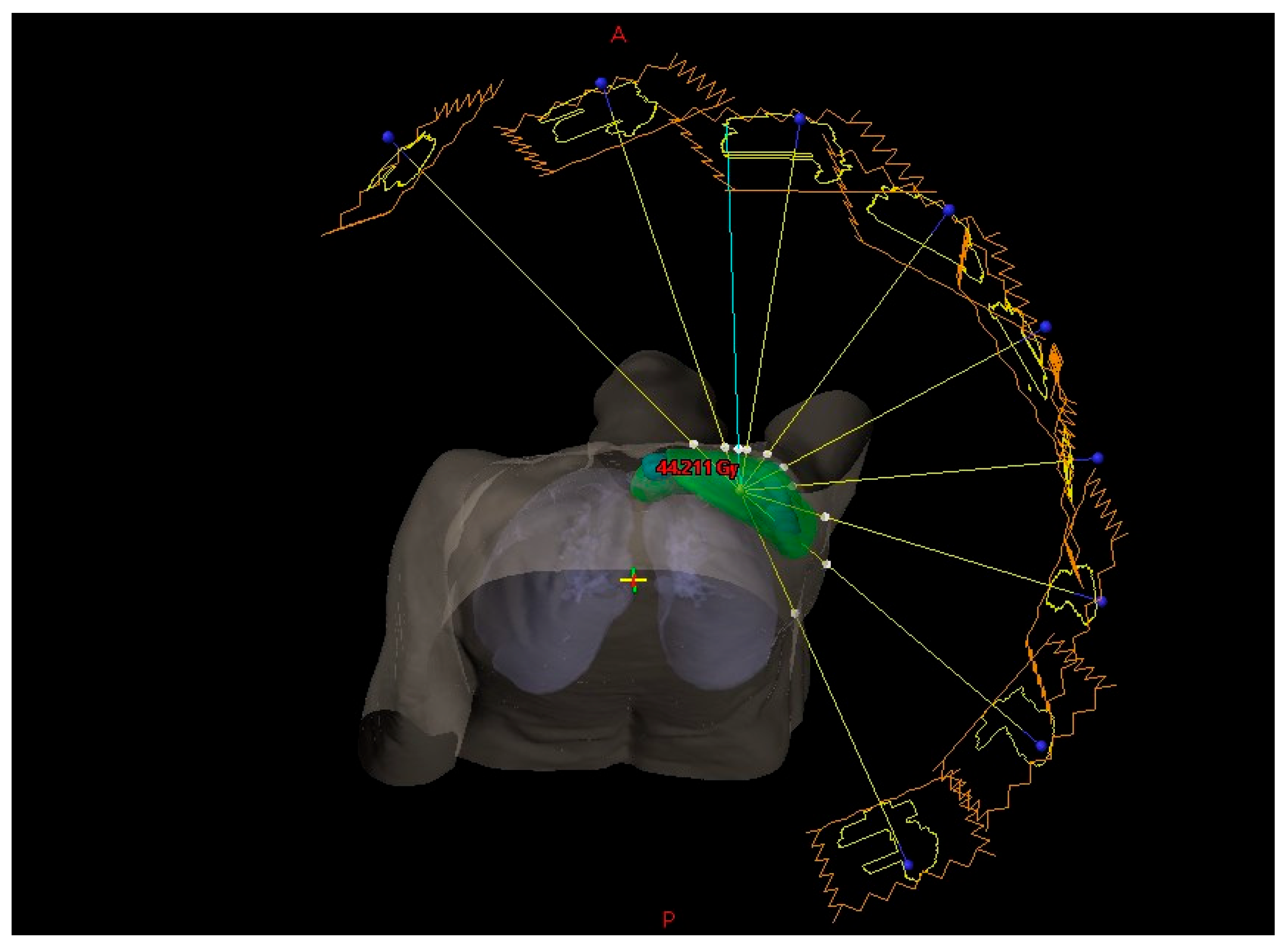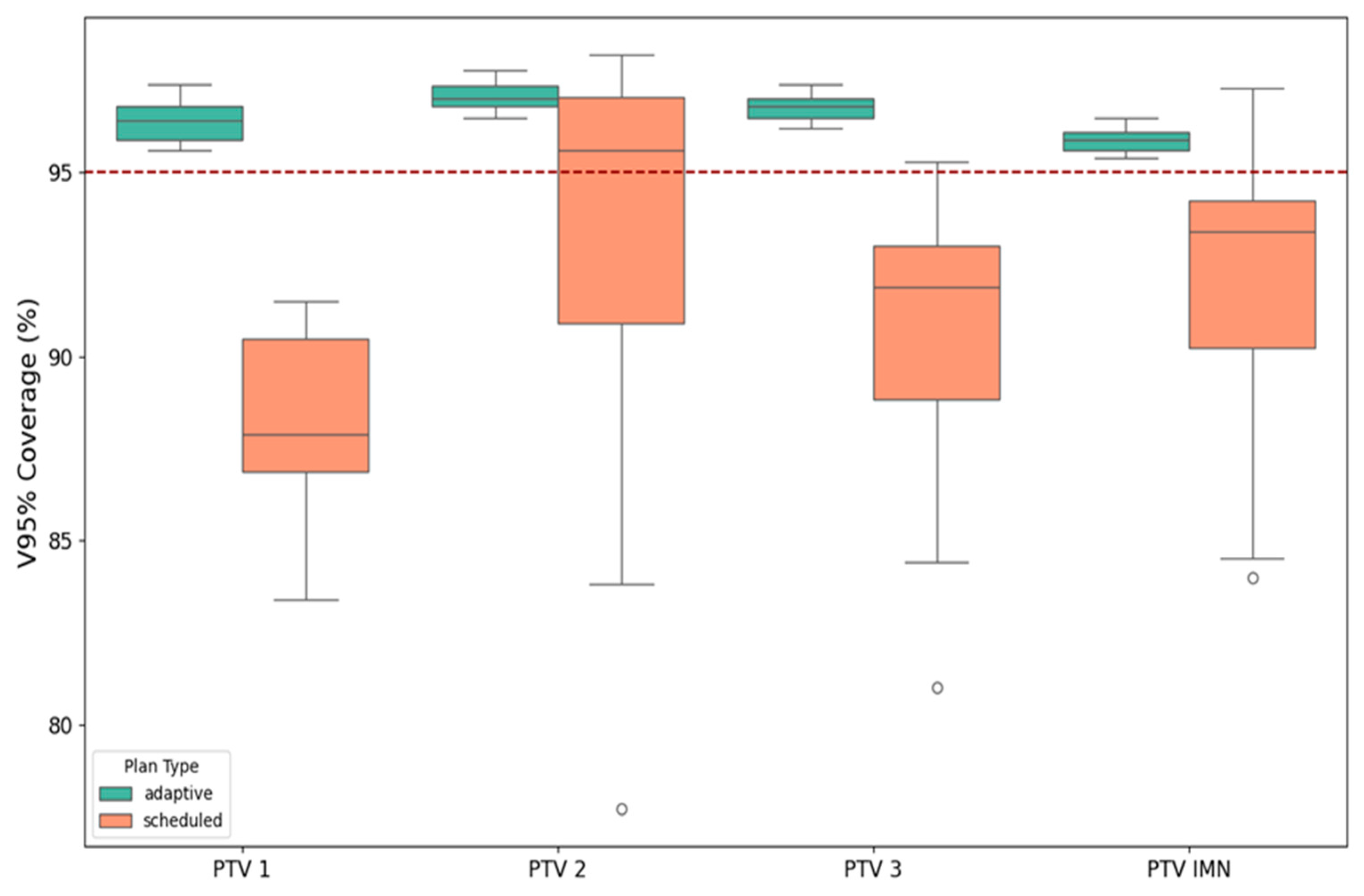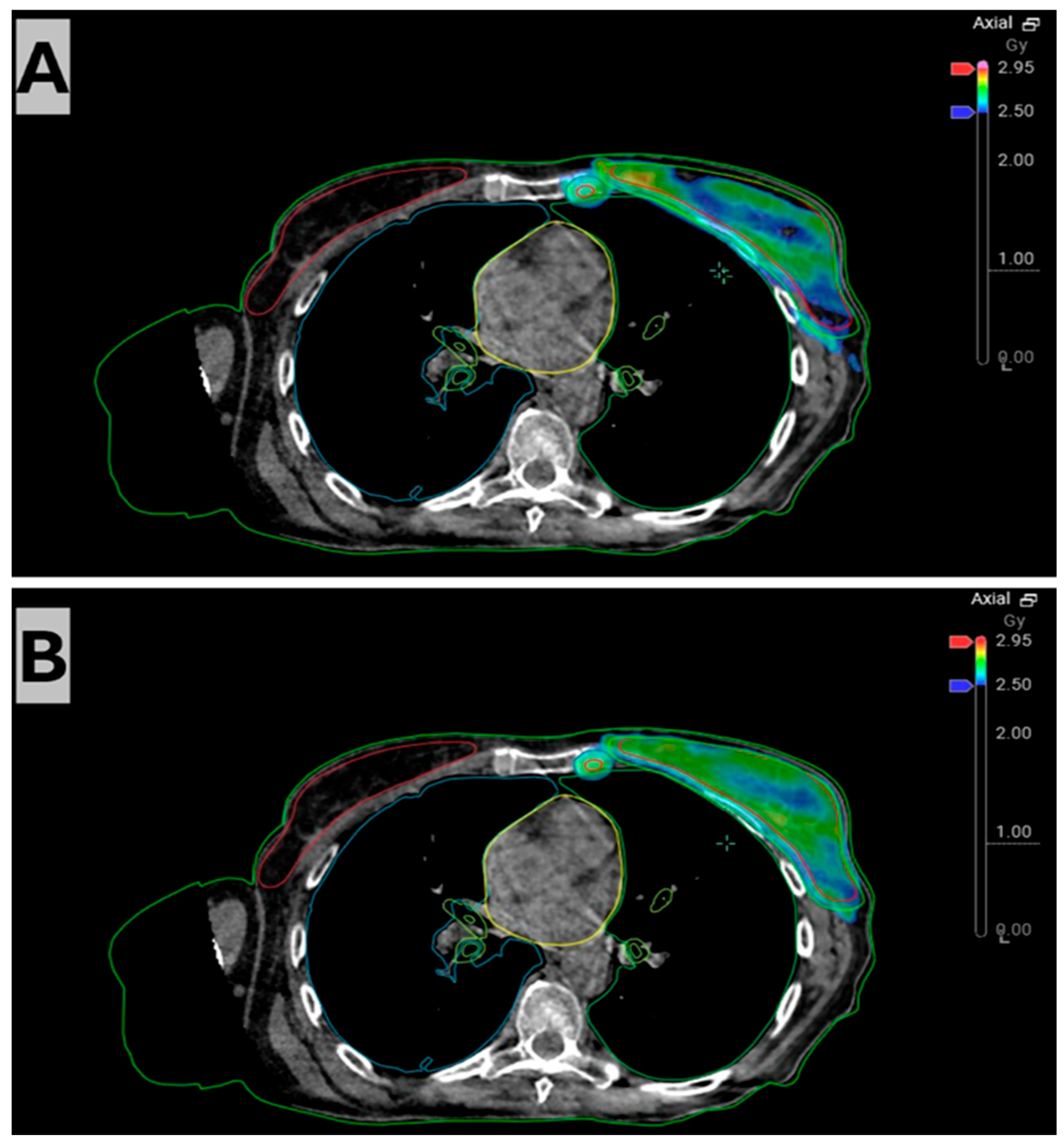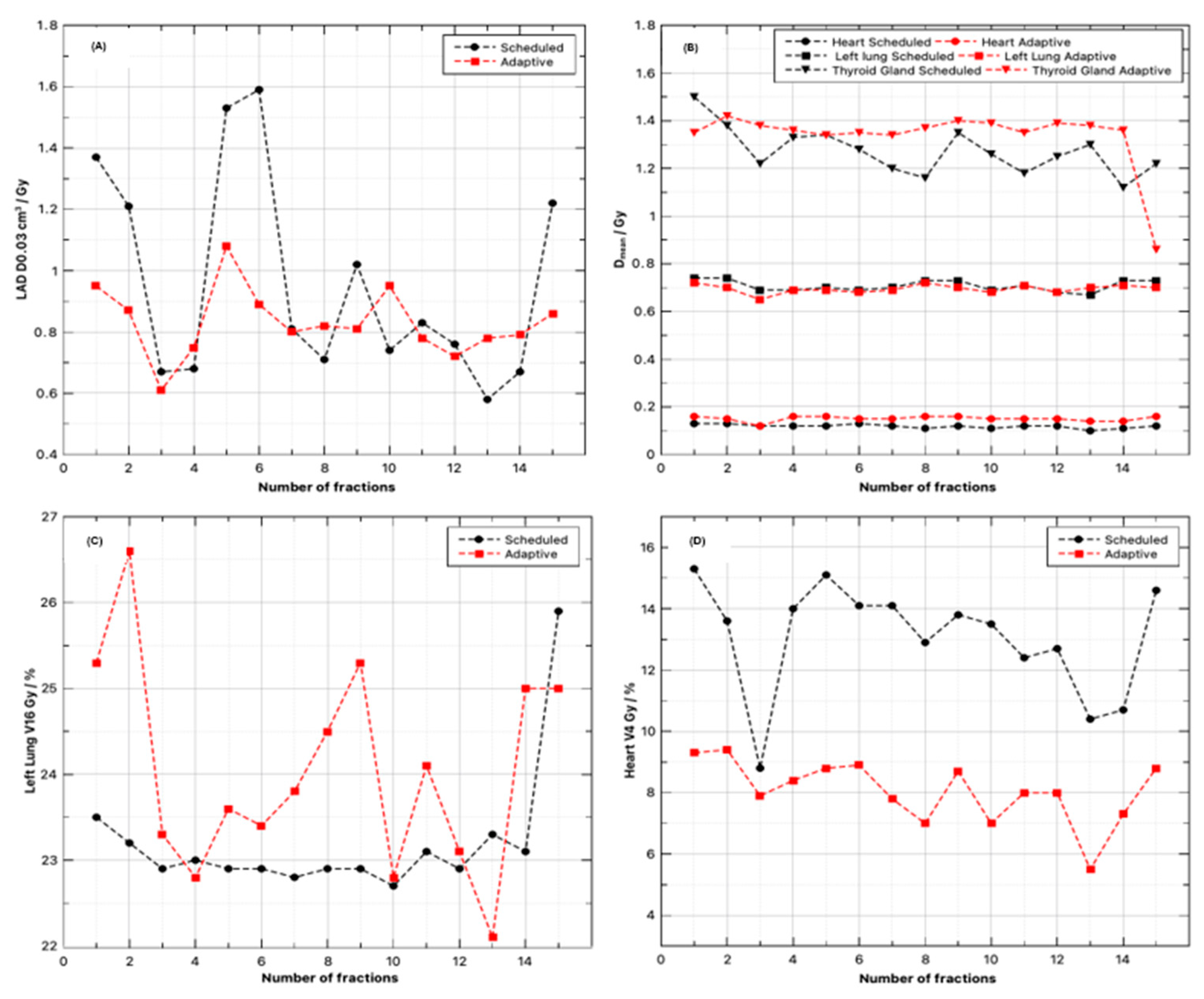Online Adaptive Radiotherapy for Left-Sided Breast Cancer with Comprehensive Regional Nodal Coverage Including the Internal Mammary Chain: Case Report and Narrative Review
Simple Summary
Abstract
1. Introduction
2. Case Description
3. Discussion: Online Adaptive Radiotherapy in Breast Cancer
3.1. Adaptive Radiotherapy Platforms
3.2. Technical Challenges-Platform-Driven Considerations
3.3. Clinical Evidence to Date
3.4. Perspective and Ongoing Studies
3.5. Cardiac Dose Considerations in Adaptive Breast Cancer Radiotherapy
4. Conclusions
Author Contributions
Funding
Institutional Review Board Statement
Informed Consent Statement
Data Availability Statement
Conflicts of Interest
References
- Offersen, B.V.; Boersma, L.J.; Kirkove, C.; Hol, S.; Aznar, M.C.; Sola, A.B.; Kirova, Y.M.; Pignol, J.P.; Remouchamps, V.; Verhoeven, K.; et al. ESTRO consensus guideline on target volume delineation for elective radiation therapy of early stage breast cancer, version 1.1. Radiother. Oncol. 2016, 118, 205–208. [Google Scholar] [CrossRef]
- Poortmans, P.M.; Collette, S.; Kirkove, C.; Van Limbergen, E.; Budach, V.; Struikmans, H.; Collette, L.; Fourquet, A.; Maingon, P.; Valli, M.; et al. Internal Mammary and Medial Supraclavicular Irradiation in Breast Cancer. N. Engl. J. Med. 2015, 373, 317–327. [Google Scholar] [CrossRef] [PubMed]
- Finazzi, T.; Nguyen, V.T.; Zimmermann, F.; Gkika, E.; Aebersold, D.M.; Riesterer, O.; Klöck, S. Impact of patient and treatment characteristics on heart and lung dose in adjuvant radiotherapy for left-sided breast cancer. Radiat. Oncol. 2019, 14, 153. [Google Scholar] [CrossRef] [PubMed]
- Lai, J.; Hu, S.; Luo, Y.; Zheng, R.; Zhu, Q.; Chen, P.; Chi, B.; Zhang, Y.; Zhong, F.; Long, X. Meta-analysis of deep inspiration breath hold (DIBH) versus free breathing (FB) in postoperative radiotherapy for left-side breast cancer. Breast Cancer 2020, 27, 299–307. [Google Scholar] [CrossRef] [PubMed]
- Haviland, J.S.; Owen, J.R.; Dewar, J.A.; Agrawal, R.K.; Barrett, J.; Barrett-Lee, P.J.; Dobbs, H.J.; Hopwood, P.; Lawton, P.A.; Magee, B.J.; et al. The UK Standardisation of Breast Radiotherapy (START) trials of radiotherapy hypofractionation for treatment of early breast cancer: 10-year follow-up results of two randomised controlled trials. Lancet Oncol. 2013, 14, 1086–1094. [Google Scholar] [CrossRef] [PubMed]
- Murray Brunt, A.; Haviland, J.S.; Wheatley, D.A.; Sydenham, M.A.; Alhasso, A.; Bloomfield, D.J.; Chan, C.; Churn, M.; Cleator, S.; Coles, C.E.; et al. Hypofractionated breast radiotherapy for 1 week versus 3 weeks (FAST-Forward): 5-year efficacy and late normal tissue effects results from a multicentre, non-inferiority, randomised, phase 3 trial. Lancet 2020, 395, 1613–1626. [Google Scholar] [CrossRef]
- Galand, A.; Prunaretty, J.; Mir, N.; Morel, A.; Bourgier, C.; Aillères, N.; Azria, D.; Fenoglietto, P. Feasibility study of adaptive radiotherapy with Ethos for breast cancer. Front. Oncol. 2023, 13, 1274082. [Google Scholar] [CrossRef]
- De-Colle, C.; Kirby, A.; Russell, N.; Shaitelman, S.F.; Currey, A.; Donovan, E.; Hahn, E.; Han, K.; Anandadas, C.N.; Mahmood, F.; et al. Adaptive radiotherapy for breast cancer. Clin. Transl. Radiat. Oncol. 2022, 39, 100564. [Google Scholar] [CrossRef]
- Henke, L.E.; Contreras, J.A.; Green, O.L.; Cai, B.; Kim, H.; Roach, M.C.; Olsen, J.R.; Fischer-Valuck, B.; Mullen, D.F.; Kashani, R.; et al. Magnetic Resonance Image-Guided Radiotherapy (MRIgRT): A 4.5-Year Clinical Experience. Clin. Oncol. 2018, 30, 720–727. [Google Scholar] [CrossRef]
- Prunaretty, J.; Mekki, F.; Laurent, P.I.; Morel, A.; Hinault, P.; Bourgier, C.; Azria, D.; Fenoglietto, P. Clinical feasibility of Ethos auto-segmentation for adaptive whole-breast cancer treatment. Front. Oncol. 2024, 14, 1507806. [Google Scholar] [CrossRef]
- Nelson, N.; Oare, C.; Nelson, G.; Martin, T.; Huang, J.; Zhao, H. Feasibility of HyperSight CBCT for adaptive radiation therapy: A phantom benchmark study of dose calculation accuracy and delivery verification on the Halcyon. J. Appl. Clin. Med. Phys. 2025, 26, e70245. [Google Scholar] [CrossRef] [PubMed]
- Reverberi, C.; Facondo, G.; Prisco, A.; Ceschia, T.; Moretti, E.; Scalchi, P.; Pegolo, E.; Orsaria, M.; Zuiani, C.; Seriau, L.; et al. Preoperative Single Fraction Stereotactic Partial Breast Irradiation for Early-Stage Breast Cancer Patients With GammaPod Technology: Pathologic Findings and Ki-67 Evaluation. Int. J. Radiat. Oncol. Biol. Phys. 2025, 122, 1158–1165. [Google Scholar] [CrossRef]
- van Vliet, C.; Tetar, S.U.; van den Bongard, H.J.G.D.; Fraikin, T.; Jeulink, M.; Palacios, M.A.; van den Tol, M.P.; Slotman, B.J.; Bruynzeel, A.M.E. Partial Breast Radiation Therapy in Low-Risk Breast Cancer Using a Magnetic Resonance Imaging-Guided Adaptive Approach; Results of the Phase 2 PARLOB Study. Pract. Radiat. Oncol. 2025, 15, e434–e443. [Google Scholar] [CrossRef] [PubMed]
- Mueller, B.; Song, Y.; Chia-Ko, W.; Hsu, H.Y.; Zhai, X.; Tamas, P.; Powell, S.; Cahlon, O.; McCormick, B.; Khan, A.; et al. Accuracy and Efficiency of Patient Setup Using Surface Imaging Versus Skin Tattoos for Accelerated Partial Breast Irradiation. Adv. Radiat. Oncol. 2023, 8, 101183. [Google Scholar] [CrossRef]
- Prasun, P.; Kharade, V.; Pal, V.; Gupta, M.; Das, S.; Pasricha, R. Dosimetric Comparison of Hypofractionated Regimen in Breast Cancer Using Two Different Techniques: Intensity-Modulated Radiation Therapy (IMRT) and Volumetric-Modulated Arc Therapy (VMAT). Cureus 2023, 15, e38045. [Google Scholar] [CrossRef]
- Duan, J.; Pogue, J.A.; Stanley, D.N.; Shen, S.; Viscariello, N.N.; Cardenas, C.E.; Popple, R.A.; Harms, J. Assessing HyperSight iterative CBCT for dose calculation in online adaptive radiotherapy for pelvis and breast patients compared to synthetic CT. J. Appl. Clin. Med. Phys. 2025, 26, e70038. [Google Scholar] [CrossRef] [PubMed]
- van Timmeren, J.E.; Chamberlain, M.; Krayenbuehl, J.; Wilke, L.; Ehrbar, S.; Bogowicz, M.; Hartley, C.; Zamburlini, M.; Andratschke, N.; Garcia Schüler, H.; et al. Treatment plan quality during online adaptive re-planning. Radiat. Oncol. 2020, 15, 203. [Google Scholar] [CrossRef]
- Gaál, S.; Kahán, Z.; Paczona, V.; Kószó, R.; Drencsényi, R.; Szabó, J.; Rónai, R.; Antal, T.; Deák, B.; Varga, Z. Deep-inspirational breath-hold (DIBH) technique in left-sided breast cancer: Various aspects of clinical utility. Radiat. Oncol. 2021, 16, 89. [Google Scholar] [CrossRef]
- Rudat, V.; Zhao, R.; Wang, B.; Fakhrian, K.; Obeid, S.; Schramm, O.; Ahmed, M. Impact of deep inspiration breath hold, surface-guided radiotherapy, and daily CBCT on the organs at risk in breast cancer radiotherapy. Sci. Rep. 2024, 14, 27814. [Google Scholar] [CrossRef]
- Aznar, M.C.; Carrasco de Fez, P.; Corradini, S.; Mast, M.; McNair, H.; Meattini, I.; Persson, G.; van Haaren, P. ESTRO-ACROP guideline: Recommendations on implementation of breath-hold techniques in radiotherapy. Radiother. Oncol. 2023, 185, 109734. [Google Scholar] [CrossRef]
- Stanley, D.N.; Harms, J.; Pogue, J.A.; Belliveau, J.G.; Marcrom, S.R.; McDonald, A.M.; Dobelbower, M.C.; Boggs, D.H.; Soike, M.H.; Fiveash, J.A.; et al. A roadmap for implementation of kV-CBCT online adaptive radiation therapy and initial first year experiences. J. Appl. Clin. Med. Phys. 2023, 24, e13961. [Google Scholar] [CrossRef]
- Stanley, D.N.; Covington, E.; Harms, J.; Pogue, J.; Cardenas, C.E.; Popple, R.A. Evaluation and correlation of patient movement during online adaptive radiotherapy with CBCT and a surface imaging system. J. Appl. Clin. Med. Phys. 2023, 24, e14133. [Google Scholar] [CrossRef] [PubMed]
- Henke, L.; Kashani, R.; Robinson, C.; Curcuru, A.; DeWees, T.; Bradley, J.; Green, O.; Michalski, J.; Mutic, S.; Parikh, P. Phase I trial of stereotactic MR-guided online adaptive radiation therapy (SMART) for the treatment of oligometastatic or unresectable primary malignancies of the abdomen. Radiother. Oncol. 2018, 126, 519–526. [Google Scholar] [CrossRef]
- de Mol van Otterloo, S.R.; Westerhoff, J.M.; Leer, T.; Rutgers, R.H.A.; Meijers, L.T.C.; Daamen, L.A.; Intven, M.P.W.; Verkooijen, H.M. Patient expectation and experience of MR-guided radiotherapy using a 1.5T MR-Linac. Tech. Innov. Patient Support Radiat. Oncol. 2023, 29, 100224. [Google Scholar] [CrossRef] [PubMed]
- Ng, J.; Pennell, R.; Formenti, S.C. The initial experience of MRI-guided precision prone breast irradiation with daily adaptive planning in treating early stage breast cancer patients. Front. Oncol. 2022, 12, 1048512. [Google Scholar] [CrossRef]
- Civil, Y.A.; Vasmel, J.E.; Charaghvandi, R.K.; Houweling, A.C.; Vreuls, C.P.H.; van Diest, P.J.; Witkamp, A.J.; Doeksen, A.; van Dalen, T.; Felderhof, J.; et al. Preoperative Magnetic Resonance Guided Single-Dose Partial Breast Irradiation: 5-Year Results of the Prospective Single-Arm ABLATIVE Trial. Int. J. Radiat. Oncol. Biol. Phys. 2025, 121, 613–622. [Google Scholar] [CrossRef] [PubMed]
- Brunt, A.M.; Cafferty, F.H.; Wheatley, D.; Sydenham, M.A.; Kirby, A.M.; Coles, C.E.; Patel, J.; Alhasso, A.; Chan, C.; Cleator, S.; et al. Patient- and clinician-assessed five-year normal tissue effects following one-week versus three-week axillary radiotherapy for breast cancer: Results from the phase III FAST-Forward trial randomised nodal sub-study. Radiother. Oncol. 2025, 207, 110915. [Google Scholar] [CrossRef] [PubMed]
- ClinicalTrials.gov. Hypofractionated Online Adaptive Radiotherapy of Breast Cancer. Identifier: NCT06568705. Available online: https://clinicaltrials.gov/study/NCT06568705 (accessed on 17 September 2025).
- ClinicalTrials.gov. SAHARA-04: Adaptive Radiotherapy in Hypersensitive or High Locoregional-Risk Breast Cancer. Identifier: NCT06053086. Available online: https://clinicaltrials.gov/study/NCT06053086 (accessed on 17 September 2025).
- ClinicalTrials.gov. BREAST-ART: Implementation of Online Adaptive Radiotherapy for Breast Cancer on Ethos. Identifier: NCT05727553. Available online: https://clinicaltrials.gov/study/NCT05727553 (accessed on 17 September 2025).
- Qadir, A.; Singh, N.; Dean, J.; Khanduri, S.; Shaikh, F.; Lock, M.; Yartsev, S. Magnetic resonance imaging-guided single-fraction preoperative radiotherapy for early-stage breast cancer (the RICE trial): Feasibility study. Pilot Feasibility Stud. 2024, 10, 133. [Google Scholar] [CrossRef]
- Civil, Y.A.; Oei, A.L.; Duvivier, K.M.; Bijker, N.; Meijnen, P.; Donkers, L.; Verheijen, S.; van Kesteren, Z.; Palacios, M.A.; Schijf, L.J.; et al. Prediction of pathologic complete response after single-dose MR-guided partial breast irradiation in low-risk breast cancer patients: The ABLATIVE-2 trial—A study protocol. BMC Cancer 2023, 23, 419. [Google Scholar] [CrossRef]
- ClinicalTrials.gov. Real-Time MRI-Guided 3-Fraction Accelerated Partial Breast Irradiation. Identifier: NCT03936478. Available online: https://clinicaltrials.gov/study/NCT03936478 (accessed on 17 September 2025).
- ClinicalTrials.gov. MOMENTUM: Multi-Institutional Registry for MRI-Guided Adaptive Radiotherapy. Identifier: NCT04075305. Available online: https://clinicaltrials.gov/study/NCT04075305 (accessed on 17 September 2025).
- Drost, L.; Yee, C.; Lam, H.; Zhang, L.; Wronski, M.; McCann, C.; Lee, J.; Vesprini, D.; Leung, E.; Chow, E. A systematic review of heart dose in breast radiotherapy. Clin. Breast Cancer 2018, 18, e819–e824. [Google Scholar] [CrossRef]
- Schönecker, S.; Angelini, L.; Gaasch, A.; Zinn, A.; Konnerth, D.; Heinz, C.; Xiong, Y.; Unger, K.; Landry, G.; Meattini, I.; et al. Surface-based deep inspiration breath-hold radiotherapy in left-sided breast cancer: Final results from the SAVE-HEART study. ESMO Open 2024, 9, 103993. [Google Scholar] [CrossRef] [PubMed]
- Chenna, S.; Nair, S.S.; Nagesh, J.; Singh, A.; Velu, U.; Mehta, A.; Jayashree, N.P.; Gupta, M.; Krishnan, J.; Kathiresan, K.; et al. Dosimetric comparison of 3D-conformal radiotherapy, volumetric modulated arc therapy, and h-VMAT in left breast radiotherapy under free-breathing and breath-hold conditions. Sci. Rep. 2025, 15, 33095. [Google Scholar] [CrossRef]
- Bruzzaniti, V.; Abate, A.; Pinnarò, P.; D’Andrea, M.; Infusino, E.; Landoni, V.; Soriani, A.; Giordano, C.; Ferraro, A.; Strigari, L. Dosimetric and clinical advantages of deep inspiration breath-hold (DIBH) during radiotherapy of breast cancer. J. Exp. Clin. Cancer Res. 2013, 32, 88. [Google Scholar] [CrossRef]
- Lai, J.; Luo, Z.; Hu, H.; Jiang, L.; Wu, J.; Lei, L.; Qu, L.; Wu, Z. SGRT-based DIBH radiotherapy practice for right-sided breast cancer combined with RNI: A retrospective study on dosimetry and setup accuracy. J. Appl. Clin. Med. Phys. 2023, 24, e13998. [Google Scholar] [CrossRef] [PubMed]




| Trial (Registry) | Platform/Guidance | Study Design & Population | Fractionation/Target | Key Endpoints | Status |
|---|---|---|---|---|---|
| Hypofractionated Online Adaptive Radiotherapy of Breast Cancer (NCT06568705) [28] | Ethos CBCT-guided oART | Prospective postoperative cohort; breast-conserving surgery or mastectomy; WBI ± RNI | 43.5 Gy/15 fx or 26 Gy/5 fx with daily online adaptation | Dosimetric accuracy, acute/late toxicity, locoregional control, workflow time | Recruiting/active per registry |
| SAHARA-04: Adaptive Radiotherapy in Hypersensitive or High Locoregional-Risk Breast Cancer (NCT06053086) [29] | Ethos CBCT-guided oART vs. conventional IMRT | Bi-center prospective cohort; high LRR risk or “hypersensitive”; RNI (incl. IMN) permitted | Institutional hypofractionated protocols with online adaptation | Acute and late toxicity, target coverage, and feasibility of PTV-margin reduction | Announced/active (per sponsor listing) |
| BREAST-ART: Implementation of Online Adaptive Radiotherapy for Breast Cancer on Ethos (NCT05727553) [30] | Ethos CBCT-guided oART | Single-arm implementation study; WBI/CW, RNI, APBI | Departmental hypofractionation (e.g., 40/15 or 26/5) with per-fraction adaptation | Feasibility, plan quality, time-on-couch, patient-reported experience | Recruiting/ongoing |
| Study/Year (Registry) | Platform/Guidance | Setting & Population | Fractionation/Target | Design & Key Endpoints | Status |
|---|---|---|---|---|---|
| MRI-guided precision prone PBI (Ng et al., 2022) [25] | MR-linac, MRI-guided online adaptation | Early breast cancer/DCIS; prone partial breast | APBI; daily on-table adaptation | Feasibility: plan quality, coverage, early toxicity | Completed (feasibility) |
| PARLOB Phase II—MRI-guided adaptive PBI (van Vliet et al., 2025) [13] | MR-linac, MRI-guided online adaptation | Low-risk early breast cancer; postoperative APBI | SMART-style adaptive PBI | Prospective phase II; toxicity, cosmesis, early control | Completed (phase II results) |
| RICE—Single-fraction preoperative APBI on MR-linac (Qadir et al., 2024) [31] | MR-linac, MRI-guided online adaptation | Early breast cancer; preoperative APBI | Single fraction (pre-op) | Prospective single-arm feasibility; workflow, tolerance | Ongoing/feasibility published |
| ABLATIVE-2—Single-dose preoperative PBI [32] | MR-linac, MRI-guided | Low-risk early breast cancer; preoperative | Single-dose PBI | Phase II: primary pCR at 1 year | Recruiting |
| MAPBI—Real-time MRI-guided 3-fraction APBI (NCT03936478) [33] | MR-linac MRI-guided | Early breast cancer post-lumpectomy | 3 fractions over 1 week | Phase II: safety/feasibility, dosimetry | Recruiting |
| MOMENTUM Registry (NCT04075305)—MR-linac multi-tumor registry including breast; early safety analysis in 1.5 T MR-linac shows low acute ≥G3 toxicity with online adaptation [34] | MR-linac (1.5 T), MRI-guided | Multi-site registry; includes breast cohorts | Platform-specific (per site) | Prospective outcomes, technical, and QoL data | Ongoing |
Disclaimer/Publisher’s Note: The statements, opinions and data contained in all publications are solely those of the individual author(s) and contributor(s) and not of MDPI and/or the editor(s). MDPI and/or the editor(s) disclaim responsibility for any injury to people or property resulting from any ideas, methods, instructions or products referred to in the content. |
© 2025 by the authors. Licensee MDPI, Basel, Switzerland. This article is an open access article distributed under the terms and conditions of the Creative Commons Attribution (CC BY) license (https://creativecommons.org/licenses/by/4.0/).
Share and Cite
Vučinić, D.; Lekić, M.; Mlinarić, M.; Ursi, G.; Šegedin, N.; Leipold, V.; Kosmina, D.; Kaučić, H.; Schwarz, K.; Schwarz, D. Online Adaptive Radiotherapy for Left-Sided Breast Cancer with Comprehensive Regional Nodal Coverage Including the Internal Mammary Chain: Case Report and Narrative Review. Radiation 2025, 5, 34. https://doi.org/10.3390/radiation5040034
Vučinić D, Lekić M, Mlinarić M, Ursi G, Šegedin N, Leipold V, Kosmina D, Kaučić H, Schwarz K, Schwarz D. Online Adaptive Radiotherapy for Left-Sided Breast Cancer with Comprehensive Regional Nodal Coverage Including the Internal Mammary Chain: Case Report and Narrative Review. Radiation. 2025; 5(4):34. https://doi.org/10.3390/radiation5040034
Chicago/Turabian StyleVučinić, Damir, Matea Lekić, Mihaela Mlinarić, Giovanni Ursi, Nikola Šegedin, Vanda Leipold, Domagoj Kosmina, Hrvoje Kaučić, Karla Schwarz, and Dragan Schwarz. 2025. "Online Adaptive Radiotherapy for Left-Sided Breast Cancer with Comprehensive Regional Nodal Coverage Including the Internal Mammary Chain: Case Report and Narrative Review" Radiation 5, no. 4: 34. https://doi.org/10.3390/radiation5040034
APA StyleVučinić, D., Lekić, M., Mlinarić, M., Ursi, G., Šegedin, N., Leipold, V., Kosmina, D., Kaučić, H., Schwarz, K., & Schwarz, D. (2025). Online Adaptive Radiotherapy for Left-Sided Breast Cancer with Comprehensive Regional Nodal Coverage Including the Internal Mammary Chain: Case Report and Narrative Review. Radiation, 5(4), 34. https://doi.org/10.3390/radiation5040034






